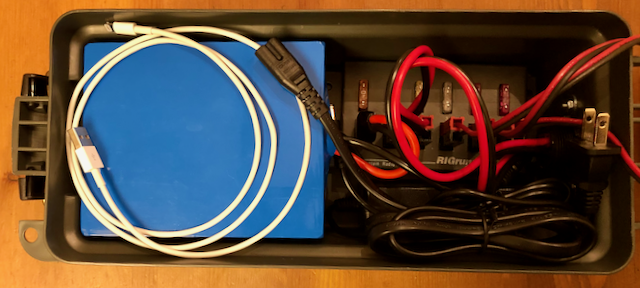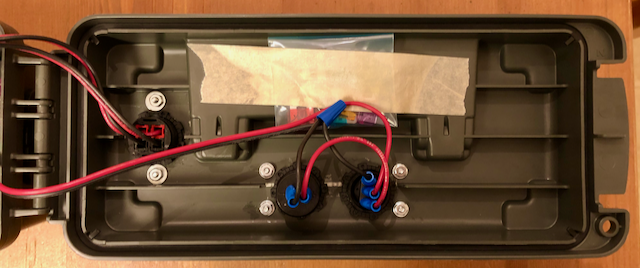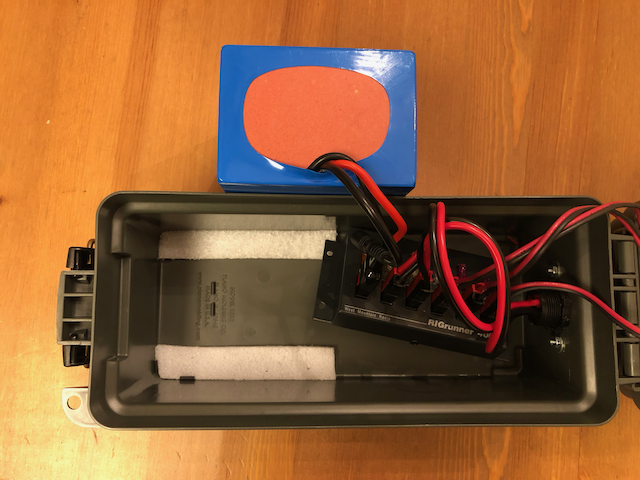WARNING: ELECTRICITY IS DANGEROUS. PROCEED AT YOUR OWN RISK.
DC power is one of the first problems to solve when operating portable. Your portable operation might take place near established infrastructure where AC power is plentiful. Remote locations will require the use of a battery. Some radios have internal batteries, but if you’re running 100W, an external battery is a likely necessity.

AC power?
Some public spaces have AC outlets available in shelters or bathrooms that can be used. These are a relative luxury since they grant you unlimited operating time at your maximum power level (or at least up to 100W). If possible, research AC power availability ahead of time. If a picnic shelter has ceiling fans, you might get lucky (looking at you Clemmons Educational State Forest). Some parks have photos that might provide hints.
If an AC outlet is available, be prepared with a power supply and extension cord. The extension cord provides operating flexibility in case an antenna or operating position adjacent to the outlet is infeasible. Operating from a picnic table via an extension cable is preferable to sitting on concrete or dirt.
If the AC outlet is out of range of the operating position, you might still find it useful for topping off your battery. I used this technique on a recent Scouting campout where I was unsure of my battery charge level and needed to run 100W SSB.
Back to Batteries
When selecting a battery, I wanted one that would provide 2-3 hours of runtime for a 100W radio. I use this battery for occasional demonstrations and POTA activations where 100W is desirable. I opted for a LiFePo battery over an AGM or SLA battery, despite the costs, for the following reasons:
- Low weight relative to capacity
- Gently sloping voltage discharge curve
The West Mountain Radio DC Power technologies, Distribution, Batteries and Solar presentation provides a good overview of battery chemistries and performance.
My portable power solution consists of a BioEnno 12V, 15Ah LiFePo battery transported inside a Plano Ammo box. I used BioEnno’s duty charts and compatibility charts to pick the 15Ah model. Although the ammo box provides a rubber O-ring to keep water out, its best feature is its handle. If it can’t be carried with one hand, it’s not portable.
The box is sized perfectly to hold:
- the battery
- RIGrunner 4005 fused DC distribution box
- 14.6V, 4A battery charger
- Spare ATC fuses for the RIGrunner, ratings varying from 1A-25A
- Phone charging cable



Construction
I built the box in a way that allows it be deconstructed, if ever needed. This allows me to easily test components, replace failed components, and “borrow” things from it, as needed. The picture below shows how everything can be taken out.

For versatility, I added two banks of PowerPole connectors, one on the lid and one under the hinge. Each PowerPole jack is connected directly to the RIGrunner. The PowerPole jacks on the lid are intended for accessories, are wired with 18 gauge cable and are fused at 3A. The bottom jacks under the hinge are intended for higher amperage devices (e.g. radios), are connnected with 12 guage zip cord, and are fused at 25A.
I added a small amount of shock protection to the battery via some foam strips I cut from a larger block.

The final touch was a switch and combination voltmeter & USB charger. The switch controls the voltmeter/USB charger, not the PowerPole jacks (it has a low amperage rating). This allows me to give my phone a boost; useful if I need to spot myself on https://pota.app or monitor Reverse Beacon Network reports. I also like the fact that I’m future-proofed for USB-C devices, like the RigExpert Stick Pro.

I tried to make the box look “professional”, so I bought the hole saw and used mounting plates for the jacks. I also went to the trouble of applying silicone between the mounting plates and the box. Hindsight being 20/20, I would skip the silicone next time. It’s messy, and the switch I used can pop out of it’s housing, dispelling any hope for it being water resistant.
Overall, I’m pleased with this solution. It gives me the versatility I need, the ability to operate 100W, and I can carry it with one hand. Not bad for a not-so-handy guy.